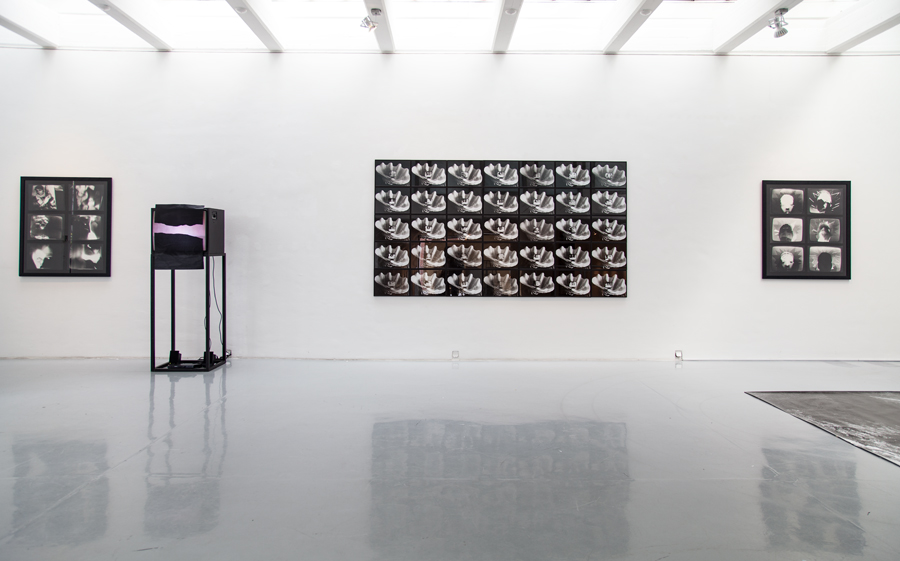Ulrike Rosenbach
Priska Pasquer, Cologne, Germany
Priska Pasquer, Cologne, Germany

Two prints show Elvis Presley as captured in Andy Warhol’s ‘Double Elvis’ silkscreens (1963): feet apart, Colt gun drawn. But these are not works by Warhol. Superimposed over this picture, we see the twofold likeness of a woman identically dressed: feet apart, Colt gun drawn. The prints are a new edition of Art is a Criminal Action, a work originally made in 1969 by the German artist Ulrike Rosenbach.
Who is Ulrike Rosenbach? Although barely known to younger audiences, her work featured twice at documenta (1977 and 1987) and at the Venice Biennale (1980 and 1984). She was also included in the early feminist art exhibition ‘1000 Miles from Here’, curated by Lucy Lippard in 1973. From 1964 to 1972 she was a student of Joseph Beuys at the Kunstakademie Düsseldorf, where she engaged with feminist ideas from the outset – hence the title of this exhibition, ‘Art Meets Feminism No. 1’. In recent decades, however, such declarations have hardly been career-enhancing Rosenbach disappeared from public view.

As well as being among the pioneers of feminist art, Rosenbach was one of the first video artists, full stop. As early as 1973, she began using a video camera because the medium allowed her to better define her role as a woman artist and subject of her own art. It provided a dynamic way of challenging historical representations of women in European art, where they were often depicted as passive objects put on show by men, representations of the Madonna and of Venus. As John Berger writes in his Ways of Seeing (1972): ‘Men look at women. Women watch themselves being looked at.’ It thus became Rosenbach’s goal, her obsession even, to claim the active role in her works. In Cologne, where she was living at the time, she also founded the School of Creative Feminism in 1976, a forerunner of later women’s networks.

In one of her best-known performances, Glauben Sie nicht, dass ich eine Amazone bin (Don’t Believe I’m an Amazon, 1975), Rosenbach superimposed her own portrait over a projection of the medieval artist Stefan Lochner’s Madonna im Rosenhag (Madonna of the Rose Bower, c.1450), and then shot at this double portrait with fifteen arrows. This allowed her to play both parts: the active attacker and the passive Madonna. The stills and photographs from this performance, included in the Cologne show, are striking in their ambivalence: both passively submissive and active, aggressive and rebellious. Aggressiveness is a recurring theme in Rosenbach’s work, but unlike some other feminist artists who turned their aggressiveness against themselves, hers took a political direction. She saw herself as part of a politically subversive movement – or in her words, Art Is a Criminal Action (1969), the title of the Elvis print.

‘Art Meets Feminism No. 1’ included almost all of Rosenbach’s major works from the 1970s, including her video on Sandro Botticelli’s The Birth of Venus (c.1484), Reflektionen über die Geburt der Venus (Reflections on the Birth of Venus, 1976) and a painstaking reconstruction of the video installation Die einsame Spaziergängerin (The Lonely Walker, 1979), which deals with the myth of solitude in the work of the romantic painter Caspar David Friedrich. The Image of Woman in the Postwar Period (1994), a video wall originally made for the House of History in Bonn, was also reconstructed in a digital version. The original installation consisted of 96 screens playing videos on the roles and representation of women in postwar Germany. As the museum’s director at the time admitted, women as a theme were simply omitted from the museum’s concept. After years of relative obscurity, it was high time for this representative exhibition of Rosenbach’s video performances, photographs and subtle drawings. They have lost nothing of their freshness and topicality today – for better and perhaps, also for worse.
Translated by Nicholas Grindell
Main image: Ulrike Rosenbach, ‘Art Meets Feminism No.1’ installation view, Priska Pasquer. Courtesy: Priska Pasquer, Cologne
























